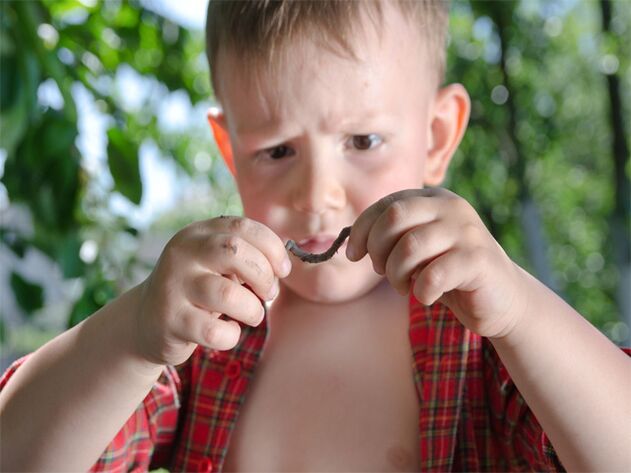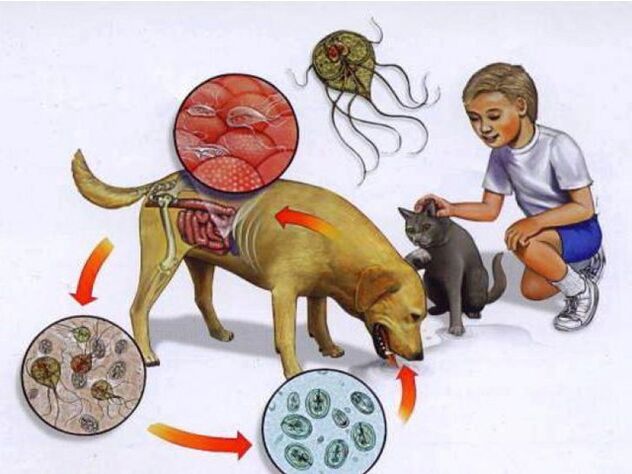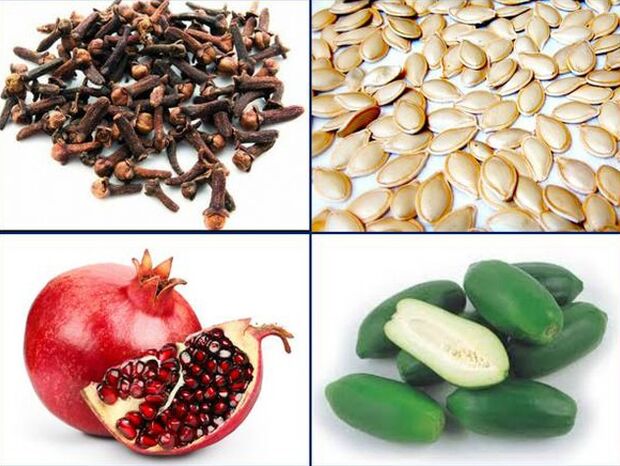There are many forms of parasites that enter the human body and live there. Infection with worms in children is one of the most common diseases. Their severity is usually underestimated. It removes nutrients from baby food, causes allergies, insurmountable intoxication, reduces immunity, and damages the abdominal organs.

According to statistics, more than half of the population is infected with parasites, and more children are infected. The early stages of the disease pass without symptoms - in a latent form. In children, worms, the symptoms and treatment that parents need to learn and understand, sometimes live in a person for many years, do not manifest themselves in anything, and are only activated by a decrease in immunity.
The spread of worms
Diseases that provoke lower worms are called helminthiases. No one is immune to them, and often infected themselves are to blame for the appearance of worms. Climate has the greatest impact on their prevalence. They are most comfortable in hot tropical countries. The number of parasites also depends on the socio-economic level: in underdeveloped regions with low levels of hygiene and medicine, especially many people suffer from helminths.
It is generally accepted that helminthiasis is a disease of the lower social classes living in unsanitary conditions and in frequent contact with soil or animals - carriers of invasions. However, statistics refute this statement: in prosperous European countries, examination reveals worms in one third of patients.
Every year, 2 million cases of infection are detected, and 20 million are based on the turnover of anthelmintic drugs. 80% of them are children. Helminths are lively, productive, and one female lays 200, 000 eggs a day.
Types of worms
There are many species of worms - more than 300, 70 are typical for our region, the rest are brought by travelers from exotic countries. All types of parasites adapted to live in the human body fall into three main categories:
- nematodes belonging to the class of roundworms, most often observed in infants (these include pinworm, whipworm, Trichinella, roundworm);
- tapeworms (flatworms) listed as cestodes (including tapeworms, tapeworms, exinococci);
- trematodes or parasites that live in the gut and reproduce, but can be transmitted to various human organs through the bloodstream. The most common infections are usually in the intestines, liver, and gallbladder, but worms can spread to muscle tissue, lungs, and even the brain and heart.
In terms of propagation, primarily pinworms with a round diameter and small parameters - no more than 6 mm. They are localized in the lower part of the column. More than 24, 000 species of nematodes are known. The female can lay 150, 000 eggs a day. Their systematic movement and proliferation in the intestine are the main reasons for the risk of secondary infection with enterobiasis.
The second most prevalent ascaris infestation is in preschool and primary school children. Mature worms look scary: they grow up to 30 cm. The female lays about 100, 000 eggs a day. Larvae enter the body with unwashed hands, dirty food and water. They are transmitted through the bloodstream to all parts of the child's body and settle there. This type of helminthiasis is very dangerous for the undeveloped child. Ascariasis is often the cause of allergic reactions in children.
Trichinella is not so common in children. They are the cause of trichinosis, which is characterized by lightning-fast transmission of eggs through the body, causing damage to muscle tissue. The consequences of trichinosis are peritonitis, intestinal bleeding.
Sources and methods of heating
It is possible if you understand the information on the prevention of helminth infections in children, the transmission of worms. In fact, there are several opportunities for them to penetrate the human body. Much of this is transmitted to humans through contact or food.
Many believe that strict adherence to the principles of personal hygiene will protect against helminthiasis. Unfortunately, this idea is wrong. Children are at higher risk of infection because they are in close contact with perpetrators. Each source of occupation has its own characteristics:

- larvae enter the body through contact with infected people, objects and animals;
- the culprits of the alimentary method are unwashed dates, questionable cleaning water, contaminated food supplies;
- worms transmit blood-sucking insects;
- with active (percutaneous) - the testicles of worms pass through the connective tissue or skin from the soil or reservoirs in the process of bathing. Sometimes airborne larvae enter the respiratory system along with dust particles.
Despite the diversity of worms, children are infected in about the same way. Eggs, larvae, a part of the body or a whole parasite, when they reach a person, begin to feed and multiply, and in the absence of therapy, their number increases rapidly. The infected person's health deteriorates and he is guilty of transmitting the occupation to others.
The eggs of the most common helminths - roundworms, pinworms, are covered with a capsule of glue, stick firmly to the surface and are stored there. Spread occurs fairly quickly. Once on the palms and fingers, the eggs are collected under the nails, from where they are transferred to everyday items used by humans. It infects all family members and those around them.
Certain types of worms can penetrate the placenta and infect the fetus in the uterus. A mother who suffers from enterobiasis is more likely to be infected at birth. A nurse can be infected by relatives of the patient, although the disease is not transmitted through breast milk. There are also non-standard cases of transmission of worm eggs from an infected person: during sexual intercourse or kissing, and in this case, contraception is useless.
It is impossible to completely protect against helminthiasis: their larvae live everywhere. However, there is an opportunity to reduce the risk of disease for those who follow the requirements of hygiene, eat heat-treated foods and undergo regular preventive treatment of worms.
Identification of helminths
Infection with parasites occurs more often in the hot season, as babies actively explore their surroundings without worrying about washing their hands, spend all day outside, in a sandbox, jump in reservoirs, feast on berries and fruits directly from the branches. and fruits.
In adults, before worms enter the body, it is necessary to force a number of obstacles: saliva in the mouth, acidic environment in the stomach, the immune defense of the intestine. Protection in children is very weak, so helminths are easier to overcome. Parents should be aware of the signs of infection in their children. Most of them are aware of a difference, such as grinding teeth at night, although this is not the only indicator. How can you tell if a child has worms? You need to pay attention to the symptoms.
General symptoms of worms
The presence of helminths in a child's body poisons him with waste products, so one of the main symptoms of the infection is increased fatigue, dizziness, refusal to eat, whimsy. The following general features are characteristic:
- allergic skin reaction - rash, urticaria, eczema;
- Digestive complications - alternating constipation and diarrhea, bloating, nausea, abdominal pain;
- reduction of protective immunity, recurrent colds, addition of fungal infections;
- manifestation of an allergic-toxic reaction to the vaccine;
- decrease in hemoglobin levels.
Parents should be especially careful about the complex of these symptoms in the baby, for example, when acute respiratory infections or liver is difficult to cure. In such cases, it is logical to assume the existence of helminth infestation.
In addition to the general symptoms of a worm infection, there are individual signs that a child has a certain parasite.
Symptoms of Ascaris
The main symptom of ascariasis in children is a dry cough with worms in children, accompanied by a rash, and two weeks later - the manifestation of general signs of intoxication, abdominal pain. A different signal is the variability of the child's nervous and mental well-being.
Pinworm symptoms
Pinworm infection is declared as dehydration of the oral cavity. Infected children complain of irritation, especially at night in the anal area. The child scratches this surface, which is full of inflammation. In girls, these symptoms are complemented by enuresis and vulvovaginitis. Appetite changes, stools are disturbed, the baby coughs, does not sleep well, the nervous system is disturbed.
Manifestations of other worms
Trichocephalus is common in temperate, subtropical climates: whipworms prefer moisture. The symptoms are not typical enough: the pain is similar to attacks of appendicitis, the baby often calls for defecation, and symptoms of colitis are observed. The result can be rectal prolapse, as well as severe anemia.
Corn worms love humidity and heat, and also prefer subtropical, tropical climates, especially Krasnodar Krai. One symptom is a rash where the parasite enters the skin. Complicated by severe anemia.
Dogs are carriers of toxocariasis, the disease is ubiquitous. The symptoms are:
- pain in the abdomen;
- decreased vision;
- disorders of the nervous system;
- allergic reactions.
May be complicated by bronchitis, pneumonia, bronchial asthma.
Echinococcosis multiplies everywhere - on all continents except Antarctica. It has been working latently for a long time, the symptoms are nervous disorders, headaches. Serious consequences are damage to the brain, lungs, liver, heart and kidneys. In children, the treatment of helminthic invasion, the symptoms of which are life-threatening, is performed surgically.
Trematodosis (opisthorchiasis, fascioliosis) is widespread on the shores of seas and rivers, the main source of infection is untreated fish. Symptoms of the disease are characterized by jaundice, muscle pain, fever and allergic rash. The disease is aggravated by ulcerative gastroduodenitis, cirrhosis of the liver, purulent cholangitis, peritonitis, chronic hepatitis.
The symptoms of childhood helminthiasis are polymorphic, the symptoms are suitable for many diseases, so it is difficult to use only the clinical picture to diagnose. More realistic results are obtained by laboratory studies - one analysis for worm eggs and should be repeated several times.
Age features of the disease
Worms in the baby
Helminths usually occur in preschool children aged one and a half or two. Babies are rarely infected with infected parasites - during intrauterine development, during childbirth, during feeding. This usually occurs after 6 months, with the onset of additional feeding, active crawling. The child does not miss any germs, bacteria, parasites. Helminths are more difficult to detect in infants than in children of different ages. Symptoms and signs of worms in children are:
- child's anxiety, sleep disturbances;
- constant fatigue, lethargy, general weakness;
- irritation and inflammation in the anal area, and around the genitals in girls;
- digestive disorders: constipation, diarrhea, vomiting, flatulence, colic;
- dizziness associated with intoxication of the body;
- weight loss, exceptions, refusal to eat;
- pale skin, white color,
- shadows under the eyes;
- rash on the body, mainly on the thighs;
- insignificant increase in temperature;
- exacerbation of chronic diseases;
- Regular cough, regardless of respiratory diseases.
In the baby, such symptoms can signal not only the invasion of helminths, but also many other diseases. That is why it is necessary to perform several stool examinations at regular intervals to confirm the diagnosis.
In 2-year-old children, the symptoms of worms are similar to the general symptoms of worms. The entry of larvae and developing forms of worms into the child's body can cause great harm to health, because in infants the defense begins to form a new, the child can not resist unwanted aggressors. The risk increases because children are ready to taste everything without knowing the principles of hygiene. Regardless of the type of worm, the manifestations of helminthiasis are similar in two-year-old children. This is:
- skin rash;
- swollen lymph nodes;
- excessive salivation at night during sleep;
- sudden increase or decrease in appetite accompanied by weight loss;
- Unexpected nausea, intestinal dysfunction.
There are also common symptoms: irritation in the anus, in girls - in the genitals, intoxication, fatigue, decreased immunity, impaired nervous processes.
The symptoms of worms in 3-year-old children are the same as before.
An important factor in the invasion of children aged 3 to 5 years is that they visit kindergartens, as well as come into contact with pets infected with worms. Children become infected with rare helminthiasis pathogens when traveling to or from exotic countries. The rapid penetration of larvae and parasite eggs into the child's body is facilitated by:
- lack of vitamins, nutrients;
- lack of protein in the diet;
- poor quality food;
- decrease in immunity.
The symptoms of worms are similar in 5-year-old children. On Dr. Komarovsky's website, you can see photos and videos on the treatment and prevention of worms, as well as read patient reviews.
Diagnosis of the disease
The appearance of the first symptoms of helminthic infestation indicates the need for special studies. In clinical practice, sufficient attention is paid to the diagnosis of helminthiasis in preschool and primary school students. Probable diagnosis should be confirmed using laboratory research methods:
- a clinical blood test that detects antibodies to certain parasitic pathogens;
- scratching for enterobiasis and fecal analysis performed three times to make a correct diagnosis;
- an analysis that assesses the intestinal microflora.
They look at the color of the whole blood test. The diagnosis is confirmed by the fact that the index is higher than determined, the number of eosinophils increases, hemoglobin, on the contrary, decreases and anemia is expressed. A blood test for enzyme-linked immunosorbent assay for parasites is performed intravenously on an empty stomach. The effect is almost one hundred percent reliable, reliable, and even able to determine the type of worms, the damage caused by worms to the baby's body.
Analysis of helminth eggs and dysbacteriosis is based on fecal examination. Fecal tests for worms do not always give results, so they are performed repeatedly. Biological examination of sputum, bile, urine analysis, fecal coprogram are used to clarify the diagnosis. Opisthorchiasis is diagnosed by examining the contents of the bowel and duodenal intubation.
Additional diagnostic methods include ultrasound of internal organs, radiography, computed tomography, MRI. They help a specialist to determine the presence of helminths in the internal organs. The combination of these studies allows to confirm or deny the diagnosis of enterobiosis. The sooner the diagnosis is made and the worms are treated in children, the less the baby's health will suffer.
Recovering from invasions using the traditional method
The serious consequences of helminthiasis force us to take a responsible approach to the treatment of the disease, to contact a specialist - a parasitologist or pediatrician. Medical treatment consists of 3 stages.
The preparation phase involves the administration of sorbents and antihistamines to rid the baby's body of toxins accumulated during the life cycle of the parasites.
Anthelmintic therapy consists of the choice of drugs depending on age, type of pathogens, stage of the disease. Usually, a single dose of the drug is prescribed in the form of tablets or suspensions. The course is repeated after 2 weeks.
Antihelminthic drugs are very toxic, so when prescribing them, care should be taken to avoid harm to the child's health. Dose moderation is of great importance. Self-medication is not recommended, and medications should sometimes be prescribed by a physician who can prescribe a combination of medications. It is recommended to carefully read the contraindications of the anthelmintic agent.
The cleansing scheme is carried out after the use of antihelminthic drugs, when the parasites die, leaving the body in the feces. At this point, there is a huge splash of toxins in the baby's body. Enemas are prescribed for cleansing, absorbers and choleretic drugs are taken. Blood and stool tests should be performed again after the course of treatment. If there are complications, the baby is registered for 3 years.
Folk remedies
Herbal healers have a long history of getting rid of parasitic worms. Basic medicine recognizes the benefits of some of these remedies. However, all this does not guarantee results. It is advisable to coordinate their use with a doctor. The following folk recipes are considered the most effective:

- use of pumpkin seeds;
- use of hemp, pumpkin, flaxseed oil;
- garlic enema with milk;
- use of soda enemas;
- carrot juice;
- tansy infusion: 3 tbsp. l. tansy is poured into a glass of boiling water, insist for an hour, the infusion is given to the child to drink 1 liter of dessert. three times a day; overdose is unacceptable in the absence of depression of the nervous system;
- maple resin;
- herbal infusions, wormwood enemas.
Preventive measures
To protect the child from helminthic invasions, certain rules must be strictly observed:
- teach the baby to wash his hands thoroughly before eating and after walking;
- cut nail plates systematically;
- change the costume for the child more often;
- to keep household items and toys clean;
- keeping tetrapods at home is undesirable;
- to teach not to take your fingers or toys in your mouth for walking;
- Carry out prophylaxis in the form of taking medication for the whole family once a year.
Worm infection is a serious problem. The disease is very common in the world, and children are especially susceptible. The disease can last for years and can cause great harm to the baby's health. Worms release toxins as long as they are present, causing the appearance of various diseases that give the child a lot of discomfort and unpleasant feelings. Therefore, parents should see the symptoms in time and start treatment with the help of a specialist.






































